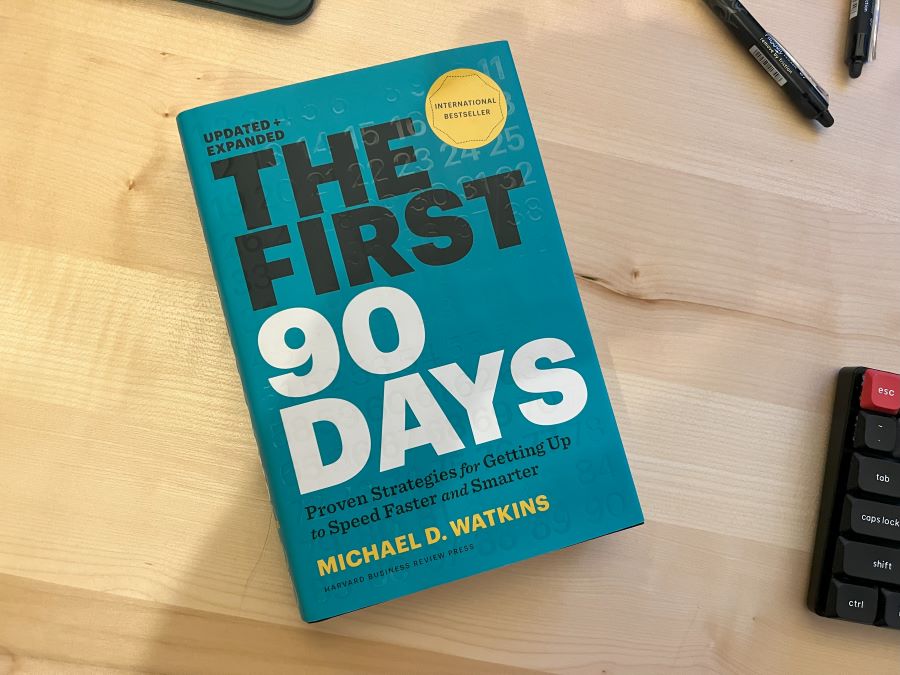
Book Review: The First 90 Days by Michael D. Watkins
I like reading both technical and business-oriented books, but I always feel like I forget a lot of the information I read before I even finish reading. To better retain what I learned from a book and my key takeaways, I decided to write a little review of each book I read. Hopefully, someone else (maybe you?) can find some value in this article.
In this article, I’m taking a look at The First 90 Days by Michael D. Watkins. A book that helps you find ways to get up to speed faster in a new organization or role.

Why I read this book
As a consultant, I’m supposed to be able to hit the ground running. I want to build a relationship of trust and understanding as quickly as possible. First impressions matter and those first days, weeks, or months can make or break a relationship and a project.
Since that’s the exact thing the book promises to help you with, I decided to give it a go and see what I could get out of reading it.
Accelerating your learning process
The book is split into two big parts with a different focus. The first part is about getting yourself up to speed and accelerating your learning process in your new role. Because the faster you learn about the organization, your boss/client, … the faster you can make an actual impact. The book suggests making a 90-day learning plan, where you should dedicate time to learning your job, but also to learning about the new organization you ended up in.
This is something I have recently been applying and it honestly works great. Learning about everything around you in a chaotic, unstructured way slows you down. If you are intentional about learning in your new role, you can significantly decrease the duration of your stint as the least-knowledgable guy/gal in the building.
A second key takeaway is finding out what your boss/client thinks is most important, and focussing on that first. Building trust this way will enable you to make other decisions with their support in the future. This seems obvious, but the part that’s important here is that you communicate and establish what is important truly. Misconceptions about importance and priority can be damaging to your reputation in your new role.
Another key takeaway for me was to focus on quick wins. Speaking from a developer’s standpoint, if you’re only just getting started on a project, don’t try to overhaul the entire codebase. Instead, focus on small pieces where the most ‘pain’ exists and fix those quickly. Only move on to the big issues when you’ve built trust and people have seen what you can do.
The above is pretty much applicable to anyone, at whatever level you may be. Starting your first job or 20 years of experience under your belt? Both should have an easy time finding value and learning something new and applicable.
Managing organization, strategy, and people
The second part is about managing organizations, strategy, and people. How do you choose the right strategy for a team or company if you have only worked there for a month? How do you build a winning team of people, when you don’t know anyone?
Mostly the book gives you tools to determine which approach you should use to make changes within an organization because there’s no one-size-fits-all solution. The book also puts a big focus on building relationships and finding allies when you’re trying to make changes in an organization.
If you don’t have these kinds of responsibilities you probably won’t pick up something you can use immediately, but it’s still an interesting read to help give you a better understanding of that side of doing business. And who knows where you’ll be in 10 years from now.
In conclusion
If you’re someone who regularly needs to switch between organizations and roles, I highly recommend this book. There are a lot of useful insights to be found.
Besides just theory and general ideas, there are also some frameworks in the book to help you get started the right way. I did find most value in the first part and had a bit of a harder time working my way through part two.
Thanks for reading! If you would like to stay up-to-date with my blog, consider subscribing to the codecrash newsletter. You'll receive an email whenever I publish a new article.